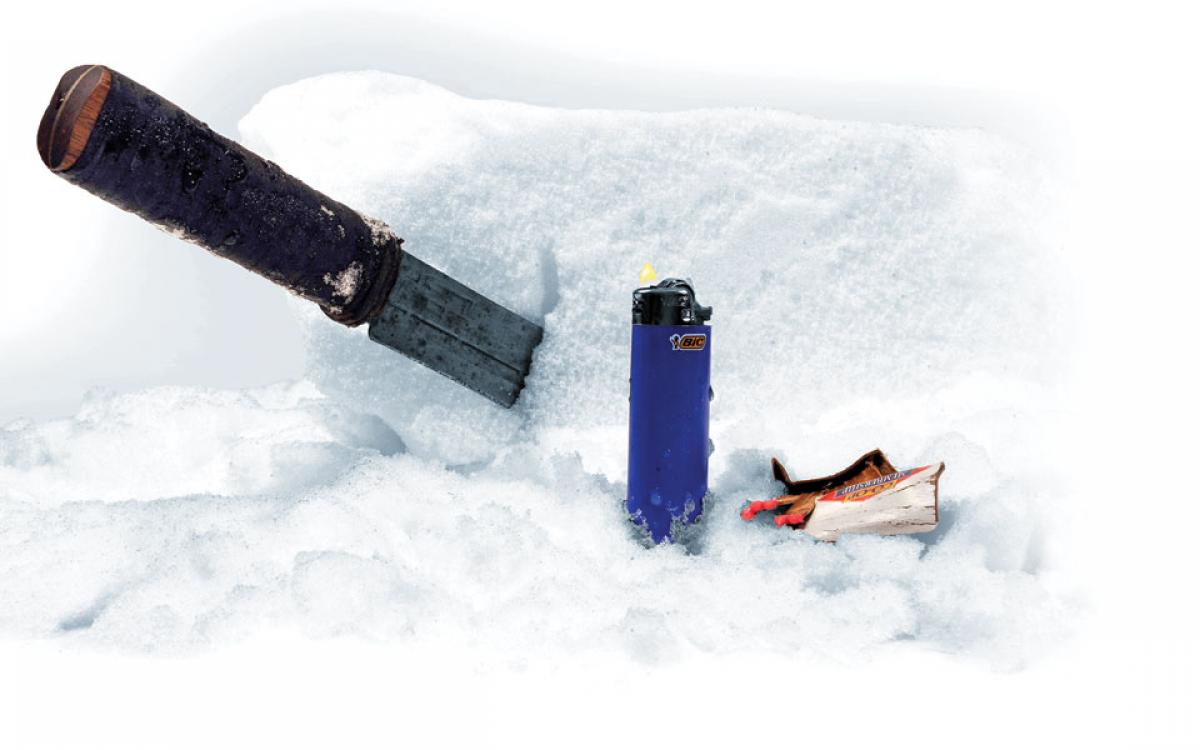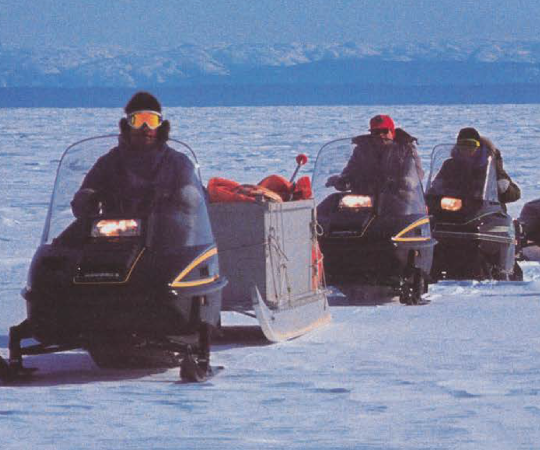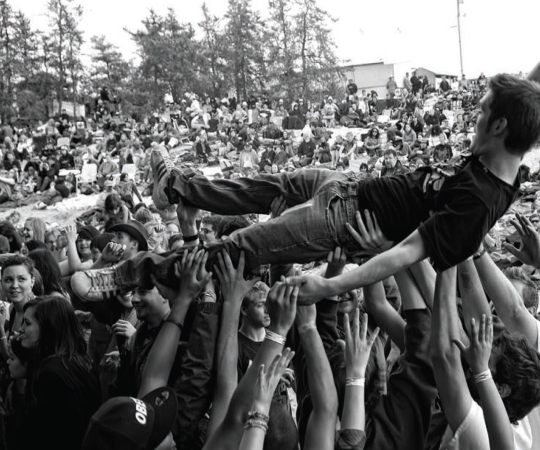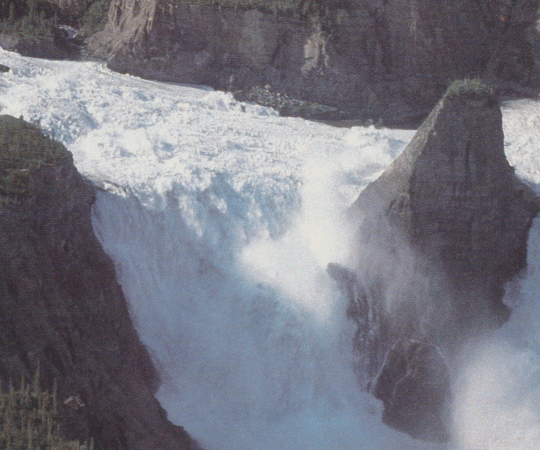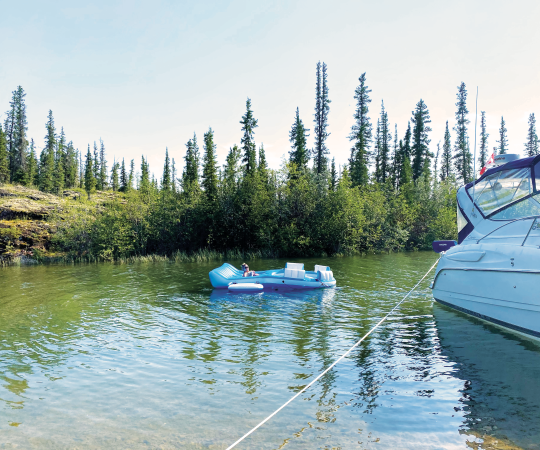"Victory awaits him who has everything in order—luck, people call it,” writes famed polar explorer Roald Amundsen in his book The South Pole. “Defeat is certain for him who has neglected to take the necessary precautions in time. This is called bad luck.” The difference between life and death on the land can be directly related to what you bring with you. If you packed it but can’t reach it, however, that’s just as bad.
Close to the heart
If Jimmy Noble had put his satellite phone in his qamutik box like usual, and not in his jacket pocket, he might not be with us today.
More than ten years ago, Noble and his uncle set out from Iqaluit in darkness on a bitterly cold January morning to hunt for seals. About 20 miles out of town, they saw steam rising from a river. Overflow on rivers is common during the full moon and Noble asked his uncle, an elder, how best to proceed. His uncle advised against travelling close to the shore, since they might get stuck in slush. It should be safer out in the middle. It didn’t turn out that way.
Noble’s uncle was fortunate. When he went through the ice, he was able to jump off his snowmobile and into the boat he’d been dragging behind him on a qamutik. Noble wasn’t so lucky. “Once it started to sink, I stood up on the seat, then on the handlebar. And then when it was totally going down—I didn’t know if there was a bottom to it—I took the leap of faith to jump onto my qamutik and I missed,” he says. “And that’s how I ended up wet.”
Now up to his chest in frigid water, Noble was able to call his father—using the satellite phone in the inside breast-pocket of his parka—and arrange for a set of dry clothes. Noble’s uncle told him to stay in the water for as long as he could because the moment he got out, his gear would freeze. Plus, his uncle knew other hunters would be passing by soon enough. Within 45 minutes, they’d arrived. Noble rolled onto the ice and the hunters stripped him of his wet clothes and wrapped him in a frozen caribou hide and a tarp. They spared what they could for clothing. “Nobody had extra pants or longjohns or anything like that, so I put on a sweater for a pair of pants,” says Noble. “One guy ripped apart his mitts and I put them on as socks and I stayed like that for a couple hours until help arrived.” The cold was “indescribable,” he says, but he wasn’t hypothermic. Salvation soon arrived in the form of dry clothes and a sleeping bag.
Keep fire on you
In less than 30 seconds, they went from flight to upside-down, underwater.
Pilot Ken Quackenbush and passenger Shariff Adam had been looking for moose and taking in the sights over Gordon Lake before heading back to Sandy Point Lodge, about 100 km northeast of Yellowknife. The engine of Quackenbush’s Maule M-4 failed and now it was sinking. He fumbled with the door; Adam, disoriented, managed to unclip his seatbelt and escape, swimming down toward the wing of the overturned and submerged plane at first, fighting the buoyancy of his lifejacket, before surfacing.
The two stunned men stared disbelieving at each other over the floats, before climbing up to sit on one each. They were pushed by a brisk late-September wind to an island in the middle of the large lake.
Neither man had a lighter or matches on them. Quackenbush tried five times—plunging into the cold water—to access the sinking plane and the fire-starters, SPOT device, flares and other potentially lifesaving items contained therein. ˚
He managed to grab a tarp and some soggy lunch, but little else. And the dives were beginning to take their toll. Quackenbush says Adam later told him that he was talking gibberish. “I wasn’t making much sense,” says Quackenbush. “This was actually getting beyond shivering. After I got out, we’re collecting spruce boughs, making a little bed, and Shariff found a muffin and I was trying to eat it and I couldn’t. I had no spit. I just couldn’t swallow.”
They heard floatplanes buzzing along the coast, a chopper on the south-end of the lake, but with only their orange tarp—nestled away in the bush, surrounded by fall’s reds and oranges—there was little to do to attract their attention.
As night fell, the two men hunkered down close together under the tarp to conserve body heat. They could stop shivering for five to ten seconds, Quackenbush says, before starting again. At midnight, a Hercules passed overhead, flying a grid pattern along the east shore of the lake. The Herc didn’t see them, and eventually it left.
Around 5 a.m., a snow squall hit and Quackenbush started to worry—if the weather stayed like this, and the planes couldn’t get in, he didn’t know how long they could hold out without fire. Thankfully, the snow let up and soon the skies were buzzing again. Later that morning, a helicopter sighted Adam‘s blue jacket and they were rescued. Three months later, Quackenbush was still awestruck by the tireless efforts of the search and rescue team. But all the anguish could have been avoided if he’d had a lighter, some matches or even a flint on his person. “A fire would have got us rescued right away, the same day,” he says. At the very least, they’d have been reasonably comfortable on the heavily wooded island, in dry clothes.
Dry-bag in the dead of winter
Mike Rarog was leading a squadron to reopen an abandoned airstrip 90 kilometres east of Yellowknife when suddenly he had a sinking feeling. It was close to -40 C and Rarog, an ex-mission specialist with the military and current owner of survival training company Arctic Response, felt the ice beneath him give way. He was soon chest-deep in a small creek. His army-supply cold-weather gear kept him warm, as he fought to get his snowmobile back on land. “So long as I kept moving, my insulated bib pants, parka and bad temper made the experience miserable but doable,” he says. The ordeal took about a half-hour.
“I knew I wasn’t going to freeze to death because I was travelling with other members of the squadron, but I couldn’t help but think that this could have been pretty dire if I had been on my own,” he says. His snowmobile, once wrestled out of the creek, was a block of ice, as was his survival bag, strapped to his backrest. “It would be a coin toss if I’d be able to get a fire going at that temperature in wet clothes and with severe shakes and loss of dexterity,” he says.
But without knowing it, he’d been prepared for this. He doesn’t generally pack a dry-sack in winter, but this time he did. Inside, he had polypropylene long-undies, gloves, heavy socks, a balaclava and even a fire-making kit—and they were all dry, despite the bag’s half-hour soaking. If he’d been alone, he might have been okay after all, he reckons.
Now out of the creek, Rarog was stuffed into a hypothermia wrap, strapped to a skimmer, and hauled back to town. But he had one more painful lesson to learn yet: Rarog’s colleague was racing back to Yellowknife at a pretty good clip. A little too fast actually—he “rolled the snowmobile and skimmer over and buried my face in the hard pack.”
Don’t leave home without…
No matter how prepared you are, mishaps occur. In his 25 years with search and rescue in Iqaluit, Jimmy Noble has seen it all. And he says there are items no one should head out on the land without. “At minimum,” says Noble, a SPOT or inReach device—or a more expensive satellite phone—should be taken to transmit location information in an emergency. This, for instance, would have saved Nunavut MLA Pauloosie Keyootak and his two travel companions a week of physical and mental agony—and spared the stress to family, friends and search and rescuers—after their party got turned around in a blizzard during a snowmobile trip from Iqaluit to Qikiqtarjuaq. A cellphone GPS program malfunctioned and instead of heading northeast, the three men were found nearly eight days later, 167 kilometres southeast of Iqaluit. (Fortunately, they had a small knife, which they used to build an iglu for shelter.)

